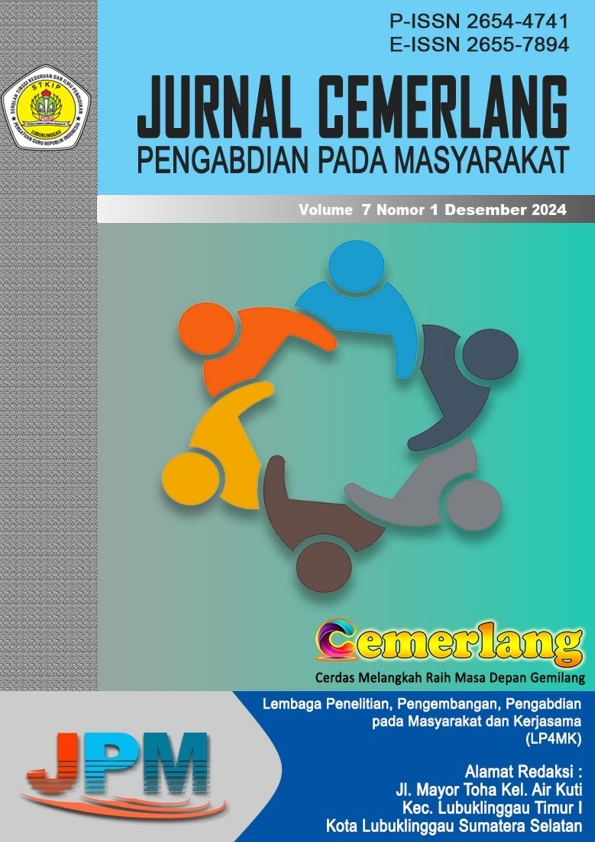Aquaponik Sederhana Dalam Meningkatkan Keterampilan dan Ekonomi Masyarakat 3T
Abstract
The specific objectives of implementing this service are: improving the skills of PKK mothers in Kelumpang Jaya Village through simple aquaponics, and improving the economy of PKK mothers in Kelumpang Jaya Village through simple aquaponics which not only relies on vegetable products, but also fish farming. Kelumpang Jaya village is the most extreme (front) village in Nibung sub-district. Access to the village can be done by ordering a taxi only once a day and the journey to the village takes 3 hours. Based on interviews and observations conducted with the PKK Team Leader, Mrs. Gustina Yati, apart from difficult access, this village also does not have an internet network. Difficult access and the absence of an internet network are also exacerbated by the low economy in this village, where the people of this village only work by relying on plantations in the form of rubber trees which are also far from settlements and rubber latex which no longer produces much. Even though this village is isolated with various problems, this village also has abundant natural potential, such as spacious home gardens, a variety of plants, and of course abundant water sources. The difficulty of access to the outside world also has an impact on the latest information or skills to process the natural potential we have into something that has the potential to generate and increase income. In fact, with the existing natural potential, Kelumpang Jaya Village can improve its economy with double profits.One of them is a simple aquaponics skill that combines growing vegetable plants with raising fish in one container at a time. Aquaponics is a very important cultivation technique because apart from being easy to apply and saving water, there is also an integration process with plant roots, where nitrogen waste from fish waste in the water can be reduced by being absorbed by the roots as nutrients. The results of implementing the simple aquaponics program for PKK mothers in Kelumpang Jaya Village show that there has been an increase in skills from 21% to 92%, apart from that there has also been an increase in the economy for PKK mothers in Kelumpang Jaya Village with the existence of simple aquaponics for one production generating a profit of Rp. ,98,000,-. This shows that simple aquaponics can be a new source of income for PKK mothers in Kelumpang Jaya VillageReferences
Darmawan, W., Irmawati, dan R. Asmuliani. Pertumbuhan dan Produksi Tanaman Selada (Lectuca sativa) dan Ikan Lele (Clarias) dengan Sistem Akuaponik.Agrium. 2020; 22(3):157- 161. https://doi.org/10.30596/agrium.v22i3.4687
Ramadhani, L.E., L.I.. Widuri, dan P. Dewanti. Kualitas Mutu Sayur Kasepak (Kangkung, Selada, dan Pakcoy) dengan Sistem Budidaya Akuaponik dan Hidroponik. Jurnal Agroteknologi. 2020;14(1):33-34. https://doi.org/10.19184/j-agt.v14i01.15481
Rozie, F., Syarif, I., Rasyid, M.U.H.A., dan Satriyanto, E. Sistem Akuaponik Untuk Peternakan Lele dan Tanaman Kangkung Hidroponik Berbasis IOT dan Sistem Inferensi Fuzzy. Jurnal Teknologi Informasi dan Ilmu Komputer (ITHK). 2021;8(1):157-166. http://dx.doi.org/10.25126/jtiik.0814025
Sastro, Y. Teknologi Akuaponik Mendukung Pengembangan Urban Farming. Jakarta: Balai Pengkajian Teknologi Pertanian. 2016
Zidni, I., Iskandar., Achmad, R., Yuli, a., dan Rian, R. Efektivitas Sistem Akuaponik dengan Jenis Tanaman yang Berbeda Terhadap Kualitas Air Media Budidaya Ikan. Jurnal Perikanan dan Kelautan. 2019;9(1):81-94. http://dx.doi.org/10.33512/jpk.v9i1
Ramadhani, L.E., L.I.. Widuri, dan P. Dewanti. Kualitas Mutu Sayur Kasepak (Kangkung, Selada, dan Pakcoy) dengan Sistem Budidaya Akuaponik dan Hidroponik. Jurnal Agroteknologi. 2020;14(1):33-34. https://doi.org/10.19184/j-agt.v14i01.15481
Rozie, F., Syarif, I., Rasyid, M.U.H.A., dan Satriyanto, E. Sistem Akuaponik Untuk Peternakan Lele dan Tanaman Kangkung Hidroponik Berbasis IOT dan Sistem Inferensi Fuzzy. Jurnal Teknologi Informasi dan Ilmu Komputer (ITHK). 2021;8(1):157-166. http://dx.doi.org/10.25126/jtiik.0814025
Sastro, Y. Teknologi Akuaponik Mendukung Pengembangan Urban Farming. Jakarta: Balai Pengkajian Teknologi Pertanian. 2016
Zidni, I., Iskandar., Achmad, R., Yuli, a., dan Rian, R. Efektivitas Sistem Akuaponik dengan Jenis Tanaman yang Berbeda Terhadap Kualitas Air Media Budidaya Ikan. Jurnal Perikanan dan Kelautan. 2019;9(1):81-94. http://dx.doi.org/10.33512/jpk.v9i1
Published
2024-12-11
Section
Articles

Jurnal Pengabdian Masyarakat by http://ojs.stkippgri-lubuklinggau.ac.id/index.php/JPM is licensed under a Creative Commons Attribution-ShareAlike 4.0 International License.













